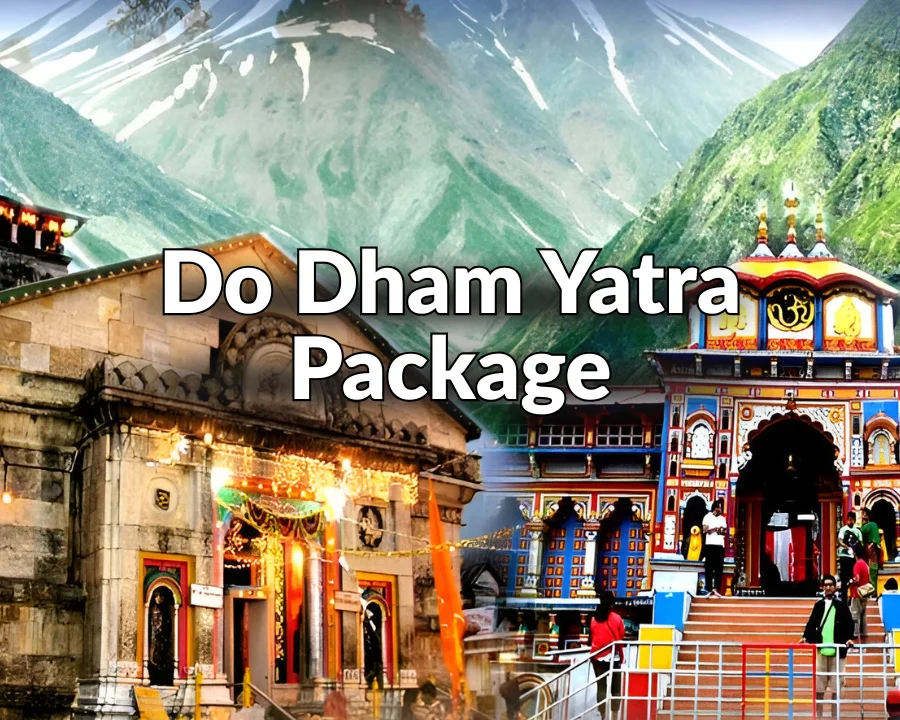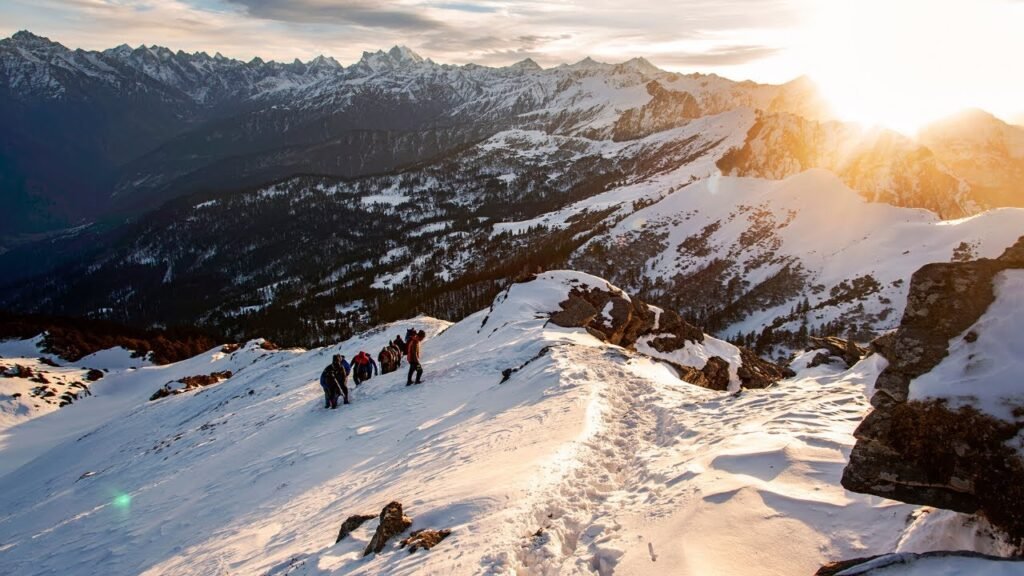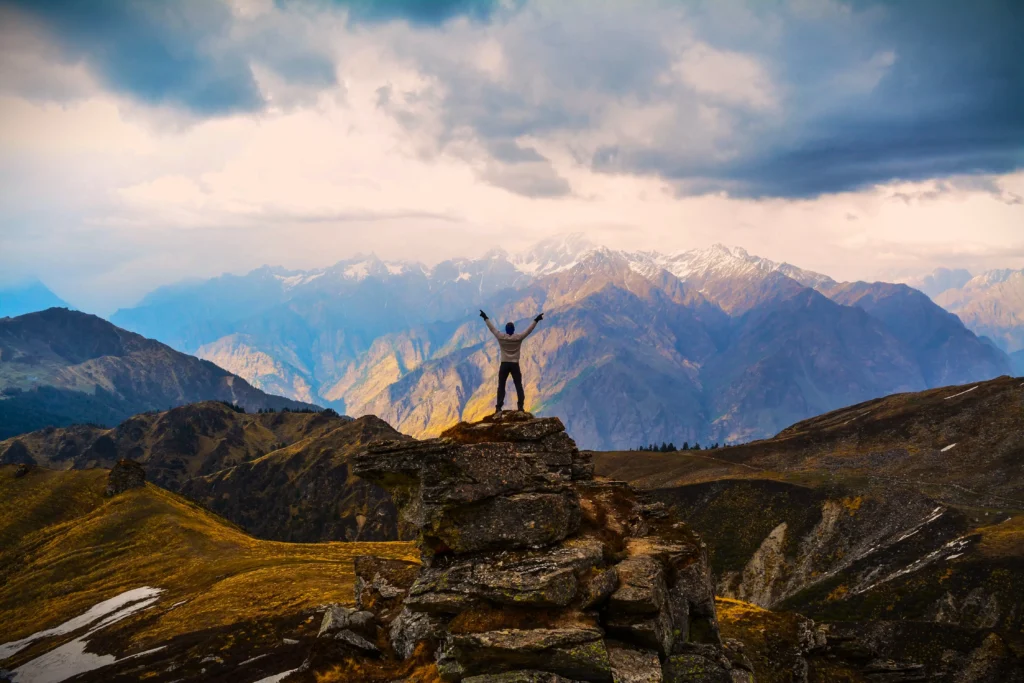
Picture yourself striding into a real-life fairy tale. A huge, high altitude Himalayan valley filled with millions of flowers covering the land in every color you could imagine. Snow-clad mountains posted stalk the distance, clear glacier fed streams snake through its meadows and a pleasant alpine fragrance fills the air of blooming flowers. This isn’t a dream. It’s the Valley of Flowers.
Nestled in Uttarakhand’s Chamoli district, this enchanting place isn’t just a trek, but more of an experience that stirs your soul. The cascade of flowers that you would witness during Valley of flowers trek is a river, it’s so vast and never-ending that despite crossing four mountains you still can’t see the end of this flower carpet. It’s one of those rare Uttarakhand treks where you get the thrill of beautiful mountain views and a flower spectacle that is found no where else on the planet.
This is a pilgrimage for trekkers, nature lovers, and photographers. It’s an opportunity to unplug from the din of the world, and plug back into nature’s quiet, life-giving rhythm. This book provides everything you need in order to plan and experience your ultimate trip. We guide you through it all, from its origins to a breakdown of each day on the trail, so you’re prepared to experience this Himalayan haven for yourself.
The Valley and Its History
The world beyond did not always know about the Valley of Flowers. For centuries, it was a hidden paradise, known only to the local villagers by dog-eared name as the land of fairies and spirits. They thought gods or something came down here and mortals who wandered too closely were taken. It was a landscape shrouded in myth and mystery.
This changed in 1931. The valley was unknown to the outside world until a British group comprising Frank S. Smythe, Eric Shipton and R.L. Holdsworth, who were on the hunt for their next adventure after scaling Mount Kamet, chanced upon it. They got lost on the way back and dropped into a colorful, lush valley. Smythe, a botanist, was entranced. He gave it the name “Valley of Flowers” and wrote a book much later, introducing this natural wonder to the world.
Spiritual roots in the valley run deep. It is also said to be that same mythical ‘Nandan Kanan’ (enthrilling garden), which finds mention in Ramayana, when Lord Hanuman had come down here on earth in search of the lifegiving Sanjeevani herb for reviving Lakshmana. This spiritual mystique adds another layer of magic to the trek.
Declared a national park to save their fragile environment in 1982. Acknowledging its unparalleled ecological value and outstanding natural beauty, Valley of Flowers National Park has been recognized by UNESCO as a World Heritage Site in 2005. Today, it is a monument to the artistry of nature and preserved for generations to come.
Trek Information: What to Anticipate on Your Trek
The Valley of Flowers trek is a moderate hike that can be done by anyone, from amateur trekkers to expert climbers. The path is marked, and the daily walking distances are reasonable.
Elevation: The hike begins from Pulna (around 6,500 ft) and the maximum elevation inside the valley is 12,140 ft (3,700 m). The trip’s climax is Hemkund Sahib (14,107 ft.), another optional but highly recommended extension.
Route of Valley Of Flowers: The trek is going from the town Govindghat. While the trek route is:Govindghat -> Pulna -> Ghangaria ->Valley of Flowers ->Ghangaria ->Hemkund Sahib ->Ghangaria- > Govind ghat.
Time: The entire trip is 6 days long including return to and from Rishikesh or Haridwar. This leaves us with travel days and a properly long acclimatization.
Difficulty Level: Easy to Moderate. It’s not the technical climbing that’s difficult, but the daily ascent and descent and getting used to the high altitude. An average level of health is sufficient to travel on foot 5‐6 hours a day.
Day-wise Itinerary – Valley of Flowers Picturesque Hike Day 1 Drive from Haridwar and Rishikesh to JoshimathOur journey to the scenic valley of flowers begins from either Haridwar or Rishikesh.

A good itinerary ensures a safe trek.
Our 6 day standard itinerary provides for the best acclimatization and proper time to explore.
Day 1: Rishikesh/Haridwar to Govindghat (Driving Distance:280kms)Travel Time: 9-10 hours
The thrill starts with journey into the middle of the Garhwal himalayas as one drives up from the plains. The roadway meanders along the sacred rivers Ganga, Alaknanda and Mandakini. Along the way, you will ride through Devprayag, where the Bhagirathi and Alaknanda rivers meet to become the Ganga. It’s a long trip, but the view is spectacular as you pass terraced fields, verdant hills and adorable mountain towns. We reach Govindghat by the evening and check into our guesthouse, turning in early after a traditional meal there getting ready for the start of our trek the next day.
Day 2: Govindghat – Ghangaria Drive (4 Km) Trek(10 km)(5-6 Hrs. Deposit luggage in Pool Kharak, take hot Lunch and start trek..Govindghat-Ghagaria is Hot Meal serve here anyone visiting valley must have Bite of Hot food it takes about 7Hrs to reach Ghagria.Interoping bridge also known as Bluetooth bridge because from this place Nanda devi biosphere park is active there is public telephone booth along with cybercafe pkg facility available.
After breakfast, we drive for a short duration to Pulna, This village is the starting point of our trek. From here, our walk begins. It’s a heaven, worth walking 10 km uphill from Ghangaria alongside the Pushpawati river. The trail is artificial with some traffic of other trekkers, pilgrims going to Hemkund Sahib and porters. You’ll hike through thick oak and rhododendron forests, waterfalls tumbling down the hillsides. The tiny, thriving village of Ghangaria, we’re here for two nights and days.
Day 3 : Ghangaria to Valley of Flowers and back (Trek: 8 km / 6-7 hours).
This is the day you wanted. We begin our trek to the Valley of Flowers after early breakfast; A brief ascent leads us to the official entry gate, where our permits are checked. When you step inside, the world is different. This path emerges from a narrow trail onto a huge, sprawling meadow. Flowers everywhere — patches of blue, pink, yellow and white. At one end stands the towering Rataban peak, at the other flows the placid Pushpawati River.
We spend some hours in the valley, even walk about 3-4 km deep inside to experience the abundance of this valley. The profusion of blooms is just amazing! With each turn, a new vista, a new carpet of flowers. One can tick the beauty in their eyes, clicking endless pictures till we cycle back to Ghangaria for the night.
Day 4: Ghangaria – Hemkund Sahib – Return (Trek: 12 km / 7-8 hours)
Today’s a tough but spiritual day. We start the steep 6 km ascent to Hemkund Sahib, one of Sikh’s holiest shrines. The pass snakes up the mountain, and the air becomes thinner as you go. But the views get better and better. From here the whole valley opens out beneath you.
14,107 ft above the ground level is Hemkund Sahib, a place full of tranquility and strength. It sits beside a glacial lake fed by seven pure and clear spring water source cascading from the surrounding snowy mountains. You might also see the rare Brahma Kamal flower in full bloom growing on the rocks beside lake. After spending some quiet moments in this serene place, we start the steep descent back to Ghangaria.
Day 5 : Ghangaria – Govindghat (Trek 10 km, Trek time: 4-5 hr.)
Images of brilliant blossoms and holy lagoons filled our thoughts as we made our way back. Returning to Govindghat is relatively rapid and painless. Back on the same beautiful trail, we arrive at Govindghat by early afternoon. We reach our guesthouse and celebrate the end of the trek with a nice party.
Day 6 : Govindghat – Rishikesh/Haridwar (280kms/9-10hr)
Drive to rishikesh which is one of the most visited spiritual site in India, and don’t miss to visit laxman Jhulla.
We decide to fuel up at the small mountain town for our last breakfast in the hills, and then climbed back into our jeeps for an equally long drive back toward Rishikesh/Haridwar. On the journey back we have time to reflect, and think of all of the amazing scenery and adventures we have encountered during this past week. You will be transported back to your destination with a piece of magic enveloping you till evening falls!
Ready to reserve your place on this amazing journey? Led by expert guides our treks are safe, comfortable and memorable. [Suggested place for a link to the booking outbound on your site]
When to Go: A Seasonal Guide for Valley Of Flowers
The Valley of Flowers is open only for a few months in a year. The best time to go is from July through mid-September, when the monsoon rains turn the valley into a jungle of green.
July — This is the time when the valley begins to bloom. The snow has melted, and the first bloomers poke above ground. The scenery is lush and green, and the crowds a bit less dense. Among the flowers, geraniums, marsh marigolds and potentillas abound.
August: This month has the best season for visiting the Valley of Flowers trek. The flowers are at their most resplendent, over 500 species blooming in all their glory. In spring the valley blooms into a montage of colour, dominated by balsam and cobra lilies and the famous blue poppy. It’s a little rain and sunshine combined, for an ethereal misty atmosphere.
September: As the monsoon subsides, color returns to the valley. Green is replaced by reds and browns in the fall. As the number of flowers diminishes, the weather clears up and you have a great opportunity to view those beautiful Himalayan peaks. Great time for photographers who like their mountain photos crisp.
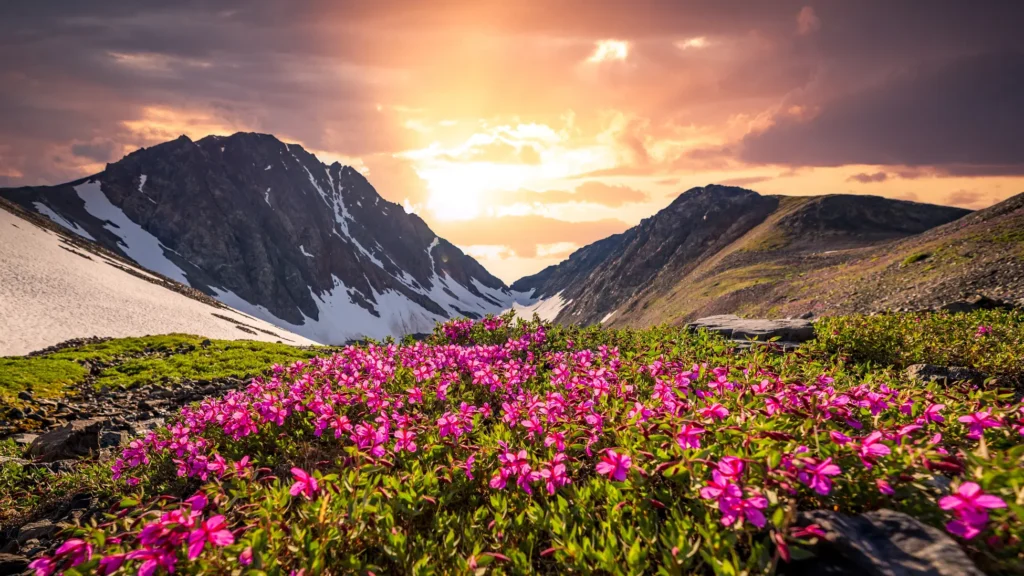
Flora and Fauna: Valley Of Flowers
The valley is a botanist’s dream. It is home to a variety of alpine flora, several of them endemic to the region and with healing properties. Highlighted attractions Some of the star attractions:
Blue Poppy (Meconopsis aculeata): The queen of Himalayan flowers, this rare and stunning sky-blue flowered poppy.
Brahma Kamal (Saussurea obvallata): – The state flower of Uttarakhand is found at high altitudes, particularly around Hemkund Sahib. It’s a holy flower that blooms at night only.
Cobra Lily (Arisaema consanguineum) for unusual-looking spathe like a cobra’s hood.
Balsam (Impatiens sulcata): These pink and purple flowers commonly carpet the ground, forming a sea of color.
Geranium, Potentilla, Anemones: Such flowers bring bold pinks and yellows and whites to the valley colours in the local palette.
And the park is also home to endangered and rare wildlife, too. You have to be lucky to spot them, and you need a good eye. The inhabitants here are the Asiatic black bear, snow leopard, musk deer, red fox and the bharal (blue sheep). The valley is also a hotspot for birdwatching; the Himalayan monal pheasant is a common sight.
Practical Information for Your Trek
Travel Tips, Permits, and Essentials
Permits: A permit is required to enter the Valley of Flowers National Park, which can be purchased at the entry gate adjacent to Ghangaria. The licence is for three days.
Accommodation: Accommodation on the trek is simple. Govindghat and Ghangaria offer guesthouses and small hotels with basic facilities. You can’t camp within the national park.
Connectivity: Mobile connectivity is unstable beyond Govindghat. There is little connectivity in Ghangaria, so tell your family before they start getting concerned.
Fitness: Begin training at least a month prior to your trek. Concentrate on such cardiovascular activities as running, cycling or stair-climbing to improve your stamina.
Essential Things to Carry
Trekking Stuff: A strong backpack (40-50L), trekkers’ poles, and a headlamp.
Footwear: Good gripping waterproof hiking shoes are a shoe-in.
Clothing: Layering is key. Wear cooling, quick-drying t-shirts that you can easily change in and out of when you need them. Bring fleece jackets as well– no matter what the climate outside, once inside a tent or lodge, it will feel cold. Last but not least don’t forget your waterproof/windproof outer jacket and pants!
Health: A personal first aid kit with high-altitude sickness, headache and stomach medicine. And bring sunscreen, moisturizer and lip balm.
Documents: Aadhaar/Voter ID/Passport (IDs are only used for the purpose of original proof).
Etc: Water bottle, energy bars, camera (with spare batteries) and power bank.
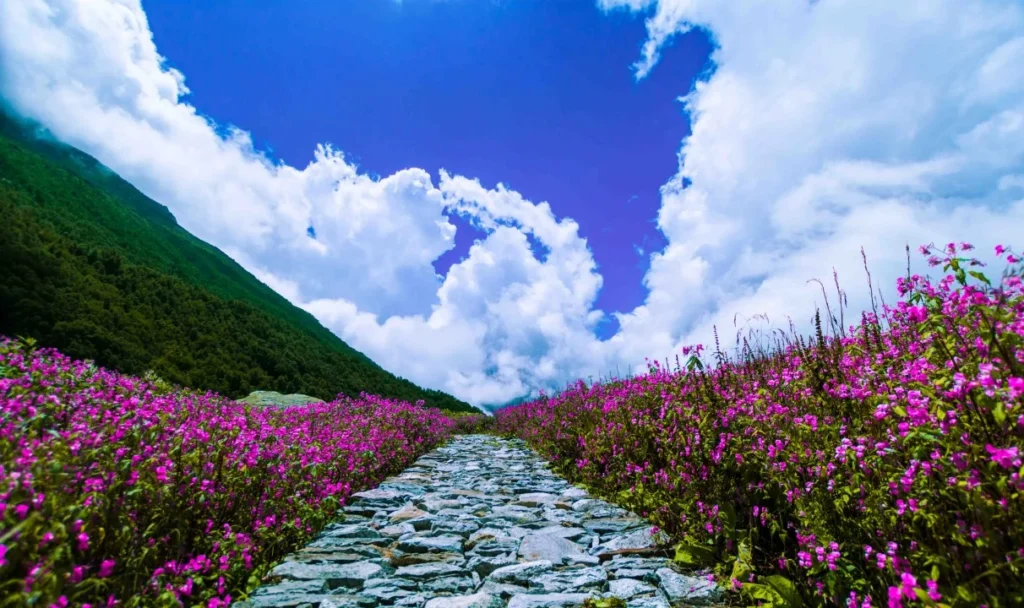
Weather Conditions to Expect
Himalayan weather can be fickle. Expect heavy stuff in those rainforests during the monsoon season (July -August). When it’s sunny, the days can be nice (12 to 20°C) but when it starts raining or you gained some altitude, it gets cold fast. Nights in Ghangaria can be as low as 4 \u2013 8 degree Celsius and you must consider a possibility of rain or cold even on sunny days.
A Photographer’s Paradise
Valley of Flowers is a paradise for photographers. Anllela’s colorful landscapes, macro floral shots, and ethereal mountain scenes have us swooning for days.
Macro Photography: Stand close up on the flowers. You can get up close and personal with a macro lens to capture the intricate details of a blue poppy or the texture of a Brahma Kamal.
Landscape Photography: A wide-angle can be used to capture the valley, while mountains stand in finally. ющей талии. The best light happens in the early morning and late afternoon.
Be Patient: Weather is always changing. In the space of minutes a hazy sight can give way to an awe-inspiring display. Be prepared to shoot these spontaneous occasions.
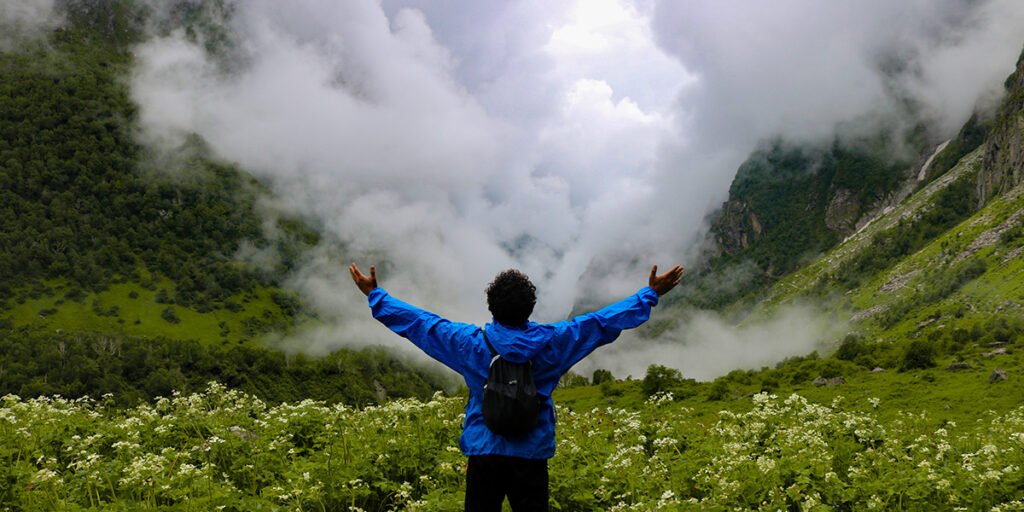
Why to Trek with The Mountain Trekker?
The right trek company can make all the difference. Here at The Mountain Trekker, we’re dedicated to providing you with a safe, empowering experience.
Professional, Local Guides: Our guides are certified professionals who have well-tested experience and know the local terrain, culture and plants. They are not simply navigators; they are your storytellers and safety experts.
Safety: Safety is the most important factor. We are first aid and high altitude emergency trained staff. For every trek, we take a full medical kit and oxygen cylinders.
Hassle-Free Logistics: From the moment you arrive in Rishikesh until you depart, we handle everything — including transport, accommodation, permits, and meals — so you can focus on enjoy. You just focus on the trek.
Responsible Tourism:we believe that all people, communities and the environment should benefit from our participation in tourism. We adhere to the ‘leave no trace’ policy on all of our treks,: we are mindful of after effects that could be caused within the fragile Himalayan environment.
Questions or Customization: If you have any questions or wish to modify this trip, please don’t hesitate to contact us.
Contact No: +91 9650644062, +91 7060358231
Email: info@themountaintrekker.com
FAQs for First-Time Trekkers
How tough is trek to Valley of Flowers?
It’s a moderate to easy hike. Trail is well marked, but there are steep portions, especially with the ascent rise to Hemkund Sahib. Anyone that is reasonably fit and can walk 5-6 hours a day can manage this trek.
Is it safe for a woman traveling alone?
Absolutely. There are always trekkers and pilgrims on the trail. When you travel with folks like us, you are always in a safe and supportive space.
What is the minimum age for this program?
We would recommend 12 years as the minimum age. It is a long walk and involves altitude, so would be pretty tough on smaller kids.
What do I do about altitude sickness?
We have a schedule to slowly acclimatize. “Walking very slowly, drinking water and eating well is the key. Our leaders are experienced in the recognition of AMS and know how to manage it.
Do we need a guide for Valley of Flowers trek?
It is possible to do the trek by yourself, but it’s much better with an experienced guide. They can identify rare flowers, tell local stories and manage logistics while you enjoy the ride.
Your Invitation to Paradise Awaits
The Valley of Flowers trek is more than just a vacation. It’s a hike that clears your soul, tests your body and awe’s your heart.” It’s an opportunity to see nature in its most raw and beautiful state, to stroll through a painting painted by God. The colorful meadows, the lofty peaks and spiritual calm with which you walk away will linger long after returning to city life.
So, are you ready to secede in the name of the mountains? Are you ready for a walk through a valley that is as if it has emerged from a myth? The path is waiting.
So, pack your bags, get into your shoes and be the part of a mesmerizing journey with The Mountain Trekker to Valley of Flowers. Let’s make memories together in this Himalayan paradise. So book your trek today and let yourself be transported to a magical land.
Join us on our journey(Contact), if you loved reading about this trek you might also like Kedarkantha Trek.


